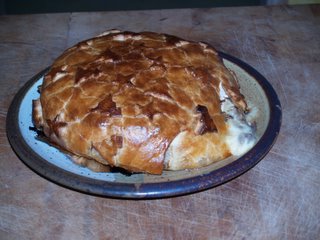So how, you might ask, do I happen to have fresh local crab for crab cakes? A few weeks ago we had sunny and unseasonably warm weather. Sport crab fishing being allowed, some industrious friends dropped a couple of pots in the harbor. On retrieving the pots and finding they had too much crab for themselves, they offered to share. Could I say no? Didn't even think of it. Took my kettle and went right over. There they were; big, fat, lively crabs set aside just for me. Oooooh, the richness of it all! I still have goose bumps. Clay and I took them home, fired up the kettle and soon were shelling and picking our treasure, packing it in freezer bags for Christmas Eve crab cakes. Well, we did eat one of them then and there as it came out of the boiling kettle. Standing at the kitchen sink. With a bottle of Champagne. It's a tradition at our house. Champagne chills in the fridge at all times. You never know...
I devised a recipe for crab cakes a number of years ago, using ingredients that had been written down and left in a restaurant where I worked for a brief moment in time. The list did not include instructions so I was left to figure the recipe out on my own. And I did. And the restaurant clients loved them! (I did not love cooking in a restaurant, however, and after 6 months went sobbing back to my own home kitchen where I've happily been since, which is another story.) I brought that recipe home with me, have changed it around a bit, adding this and that to suite my fancy.
Christine's Crab Cakes
1 tablespoon peanut oil
1 jalapeno pepper, charred, peeled, seeded and minced
1 small white onion, peeled and cut into small dice
1 cup heavy cream
1 red bell pepper, charred, peeled, seeded and diced small
2 teaspoons chopped fresh chives
leaves from 2 sprigs of fresh thyme, minced
1/2 tsp salt (optional)
1/2 cup, or more as necessary, ground toasted slivered almonds
1 to 1 1/2 lbs. cooked, picked crab meat (from about 2 crabs)
1 extra large egg, beaten lightly
1/2 cup, or more as necessary, toasted, seasoned bread crumbs
1 tablespoon peanut oil or more if needed
1 tablespoon butter, or more if needed
Place the peppers over a gas burner and char until skin is black and blistered. Place peppers in a paper bag, fold top down and allow to steam for 10 minutes. Using your fingers and a small knife, peel the skin from the peppers then remove the seeds and veins. Use latex gloves to peel the jalapeno.
Place oil in a skillet over medium heat. Add onions and saute gently until tender but not browned. Add diced jalapeno and cream. Bring to boil and maintain slow boil until cream is reduced by one half. Remove from heat and set aside to cool.
In a large bowl, add picked crab, diced red pepper, chives, thyme, salt (if using), ground almonds and cream reduction. Mix lightly but thoroughly with your hands.
Place the toasted bread crumbs (I use Brio seasoned croutons, spun a few times in the food processor) on a plate. Have the beaten egg in a bowl next to the plate. Scoop a scant 1/2 cup of crab mixture into your hands and shape into a patty about 2 1/2 inches across. Brush the crab cake on both side with the egg. Gently dredge it in the bread crumbs, coating both sides. Set on a sheet of waxed paper. Repeat with the remaining crab mixture. At this point you can cover the cakes and refrigerate them up to two days before cooking.
Place the peanut oil and butter in a skillet over medium high heat. Place up to 4 cakes in skillet, not crowding them, and cook until both sides are nicely browned and cooked through. Keep warm in a low oven. Repeat process until all the cakes are cooked.
You may notice that the cakes in the photo above have corn in them. Beginning with the basic recipe, you can add any number of things to your crab cakes. In this case, I added lightly roasted corn kernels. Keep in mind that the more you put in, the harder it is to keep the cake from falling apart. A small annoyance that does not detract from the divine taste in the least.
Top the crab cakes with a remoulade, tarter sauce, or this luscious roasted red pepper sauce, adapted from a recipe in Bobby Flay's "Bold American Food".
Roasted Red Pepper Sauce
Char, peel and seed 2 large red bell peppers and place in a blender. Add 1/4 of a red onion, chopped, 1/2 of a canned chipotle pepper in adobo, 3 tablespoons lime juice and blend until smooth. With the blender running, add 3/4 cup of olive oil in a slow stream until the sauce is emulsified. Season to taste with salt and freshly ground pepper.
Cook's Notes:















